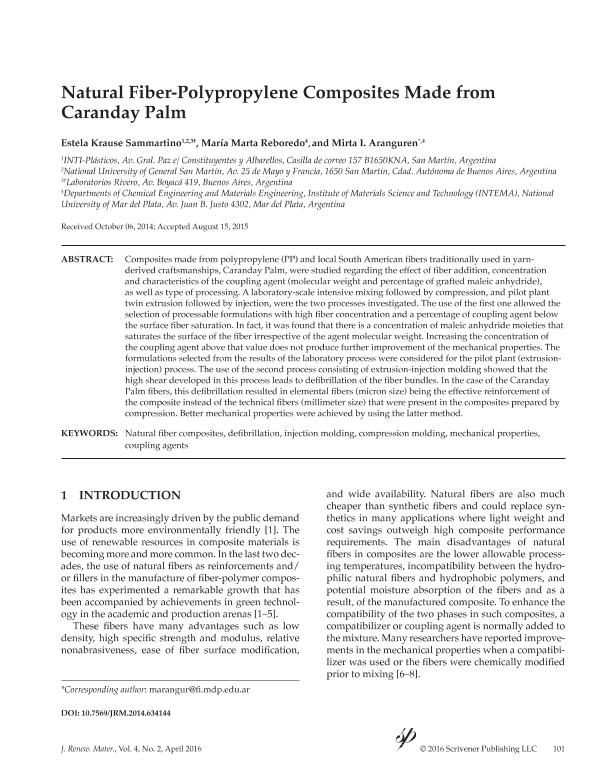Mostrar el registro sencillo del ítem
dc.contributor.author
Samartino, Estela Krause
dc.contributor.author
Reboredo, Maria Marta

dc.contributor.author
Aranguren, Mirta Ines

dc.date.available
2019-07-25T22:50:42Z
dc.date.issued
2016-04-01
dc.identifier.citation
Samartino, Estela Krause; Reboredo, Maria Marta; Aranguren, Mirta Ines; Natural Fiber-Polypropylene composites made from caranday palm; Scrivener Publishing; Journal of Renewable Materials; 4; 2; 1-4-2016; 101-112
dc.identifier.issn
2164-6325
dc.identifier.uri
http://hdl.handle.net/11336/80358
dc.description.abstract
Composites made from polypropylene (PP) and local South American fi bers traditionally used in yarnderived craftsmanships, Caranday Palm, were studied regarding the effect of fi ber addition, concentration and characteristics of the coupling agent (molecular weight and percentage of grafted maleic anhydride), as well as type of processing. A laboratory-scale intensive mixing followed by compression, and pilot plant twin extrusion followed by injection, were the two processes investigated. The use of the fi rst one allowed the selection of processable formulations with high fi ber concentration and a percentage of coupling agent below the surface fi ber saturation. In fact, it was found that there is a concentration of maleic anhydride moieties that saturates the surface of the fi ber irrespective of the agent molecular weight. Increasing the concentration of the coupling agent above that value does not produce further improvement of the mechanical properties. The formulations selected from the results of the laboratory process were considered for the pilot plant (extrusioninjection) process. The use of the second process consisting of extrusion-injection molding showed that the high shear developed in this process leads to defi brillation of the fi ber bundles. In the case of the Caranday Palm fi bers, this defi brillation resulted in elemental fi bers (micron size) being the effective reinforcement of the composite instead of the technical fi bers (millimeter size) that were present in the composites prepared by compression. Better mechanical properties were achieved by using the latter method.
dc.format
application/pdf
dc.language.iso
eng
dc.publisher
Scrivener Publishing
dc.rights
info:eu-repo/semantics/openAccess
dc.rights.uri
https://creativecommons.org/licenses/by-nc-sa/2.5/ar/
dc.subject
Compression Molding
dc.subject
Coupling Agents
dc.subject
Defi Brillation
dc.subject
Injection Molding
dc.subject
Mechanical Properties
dc.subject
Natural Fi Ber Composites
dc.subject.classification
Compuestos

dc.subject.classification
Ingeniería de los Materiales

dc.subject.classification
INGENIERÍAS Y TECNOLOGÍAS

dc.title
Natural Fiber-Polypropylene composites made from caranday palm
dc.type
info:eu-repo/semantics/article
dc.type
info:ar-repo/semantics/artículo
dc.type
info:eu-repo/semantics/publishedVersion
dc.date.updated
2019-06-11T17:45:20Z
dc.journal.volume
4
dc.journal.number
2
dc.journal.pagination
101-112
dc.journal.pais
Estados Unidos

dc.description.fil
Fil: Samartino, Estela Krause. Instituto Nacional de Tecnología Industrial. Centro de Plástico; Argentina
dc.description.fil
Fil: Reboredo, Maria Marta. Consejo Nacional de Investigaciones Científicas y Técnicas. Centro Científico Tecnológico Conicet - Mar del Plata. Instituto de Investigaciones en Ciencia y Tecnología de Materiales. Universidad Nacional de Mar del Plata. Facultad de Ingeniería. Instituto de Investigaciones en Ciencia y Tecnología de Materiales; Argentina
dc.description.fil
Fil: Aranguren, Mirta Ines. Consejo Nacional de Investigaciones Científicas y Técnicas. Centro Científico Tecnológico Conicet - Mar del Plata. Instituto de Investigaciones en Ciencia y Tecnología de Materiales. Universidad Nacional de Mar del Plata. Facultad de Ingeniería. Instituto de Investigaciones en Ciencia y Tecnología de Materiales; Argentina
dc.journal.title
Journal of Renewable Materials
dc.relation.alternativeid
info:eu-repo/semantics/altIdentifier/doi/http://dx.doi.org/10.7569/JRM.2014.634144
dc.relation.alternativeid
info:eu-repo/semantics/altIdentifier/url/https://www.ingentaconnect.com/content/tsp/jrm/2016/00000004/00000002/art00001
Archivos asociados
